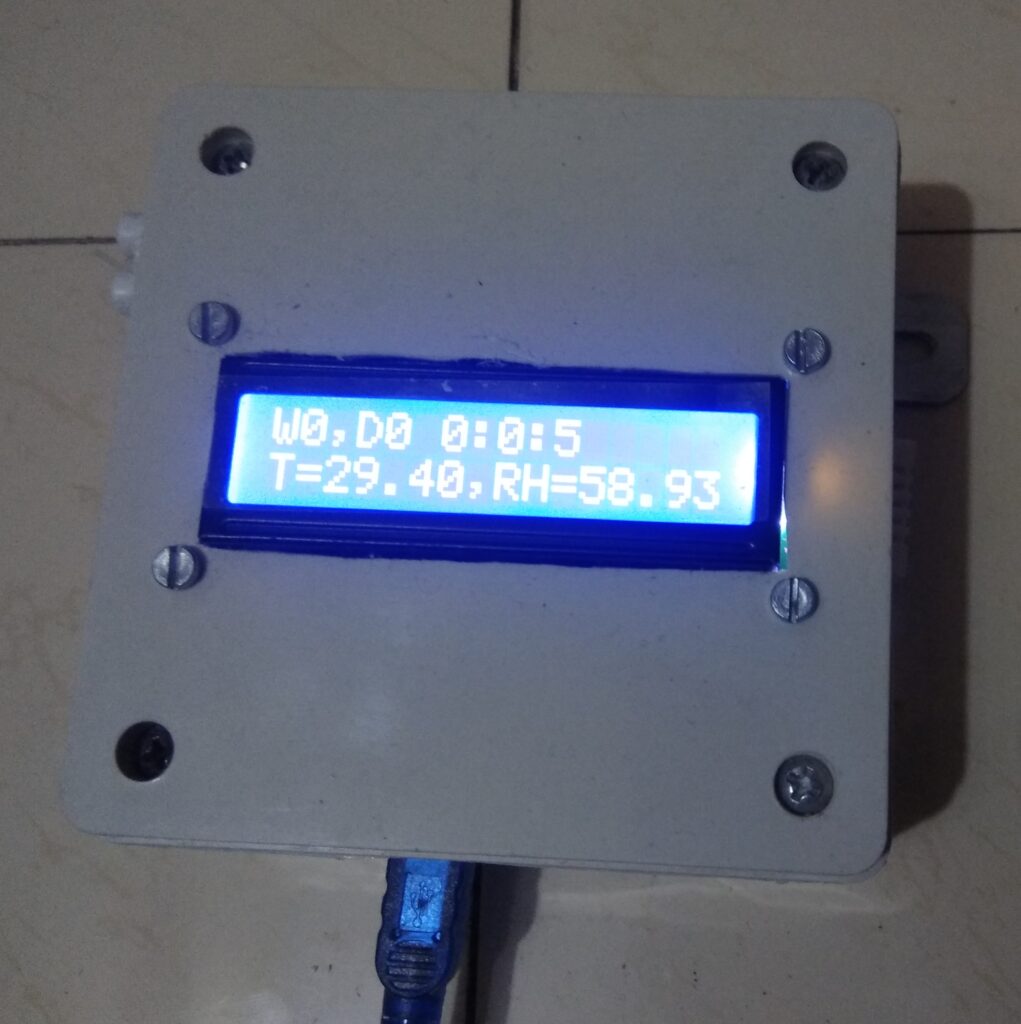For irrigation of small farms where water source is available nearby (either an open well, pond, lake or any such water body) it is possible to use small pumps and operate them on solar panels.
छोटे खेतों की सिंचाई के लिए जहां पानी का स्रोत पास में उपलब्ध है (या तो एक खुला कुआं, तालाब, झील या ऐसा कोई जल निकाय) छोटे पंपों का उपयोग करना और उन्हें सौर पैनलों पर संचालित करना संभव है।
These pumps are easily available at reasonable prices online as well as in local market in most of the cities and small towns accessible to farmers. They are used very commonly in battery operated backpack sprayers used for pesticides.
ये पंप अधिकांश शहरों और छोटे शहरों में ऑनलाइन और साथ ही स्थानीय बाजार में उचित मूल्य पर आसानी से उपलब्ध हैं। वे आमतौर पर कीटनाशकों के लिए उपयोग किए जाने वाले बैटरी चालित बैकपैक स्प्रेयर में उपयोग किए जाते हैं।
This post explains some important aspects of this type of pumps for use at small irrigation sites.
यह पोस्ट छोटे सिंचाई स्थलों पर उपयोग के लिए इस प्रकार के पंपों के कुछ महत्वपूर्ण पहलुओं की व्याख्या करता है।
Such a pump is run by a DC motor and has a PVC block head where positive displacement of water is achieved by action of miniaturized pistons inside the block.
ऐसा पंप डीसी मोटर द्वारा चलाया जाता है और इसमें पीवीसी ब्लॉक हेड होता है जहां ब्लॉक के अंदर छोटे पिस्टन की क्रिया द्वारा पानी का दबाव बढाया जाता है।
A pump having single motor is often priced at 550 to 650 INR and delivers upto 3 LPM water and claims to generate pressure of 70 PSI or 5 Bar i.e. upto 50 meters of height.
सिंगल मोटर वाले एक पंप की कीमत अक्सर 550 से 650 रुपये होती है और यह 3 लिटर प्रति मिनिट तक पानी दे सकता है और 70 पीएसआई या 5 बार यानी 50 मीटर ऊंचाई तक का दबाव उत्पन्न करने का दावा करता है।
Pump with twin motor is also available and priced at 1000 INR, delivers 5 to 6 LPM of water at similar pressure.
दो मोटर वाला पंप भी उपलब्ध है और इसकी कीमत लगभग 1000 रुपये है, समान दबाव पर 5 से 6 लीटर पानी की आपूर्ति करता है।
Next two images show a single motor and dual or twin motor pump.
अगली दो छवियां एकल मोटर और दोहरी या जुड़वां मोटर पंप दिखाती हैं।
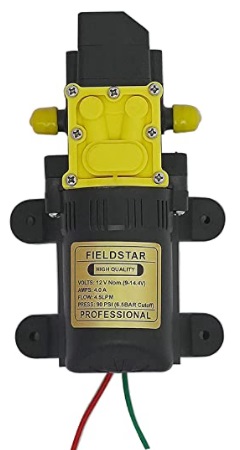
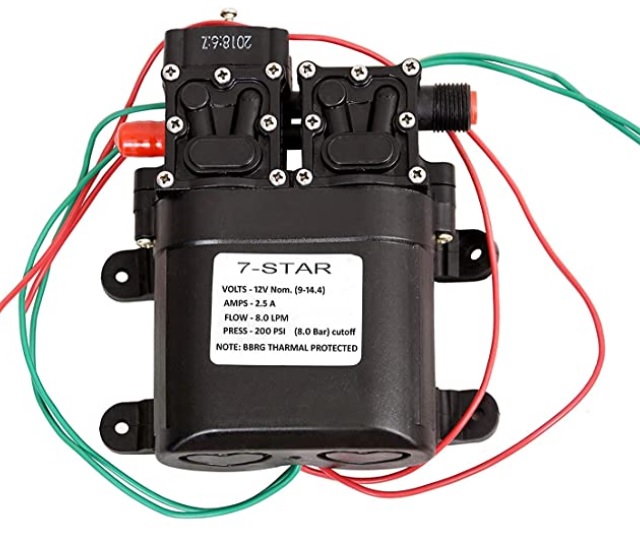
The DC Motor used is a DC motor with brushes and follows a standard specification named as 775 motor, some details can be found here.
https://somanytech.com/what-is-775-motor/

The motor can be operated over a wide range of DC supply voltage (6 to 36VDC) but the pump manufacturers normally mark the pump for operation in range of 12 to 14.5 VDC only.
We have installed such pumps at a couple of sites and safely connected to solar panels of 12VDC nominal (or 18VDC MPPT voltage). The motor of the pump nicely works with the electricity generated by solar panel during the daytime. As the intensity of sunlight changes throughout the day, the output flow of water varies and is acceptable for the irrigation purposes.
Inlet and outlet of the pump is however a non-standard (or at least not easily available) tubing size. Most suppliers provide a PVC/HDPE tube with threaded PVC nut to attach to the pump outlet nozzle, but the connectors with standard pipe sizes (say 0.5 or 1 inch nominal bore pipe) are difficult to find.
We have used a typical nozzle connection seen in pictures and created a simple skid mounted assembly of this type of pumps, eiether one pump on the skid or 2 on the skid as per the requirements.
With 2 pumps on the skid it is seen that 150 to 200 watt panels are adequate for operation throughout the day. For single pump a panel of 75 to 100 watt is appropriate.
Next few images explain the mounting approach we have used and is only a suggestion. Any suitable alternative can be followed that meets the needs and materials availability at the installation site.
Single Pump Skid
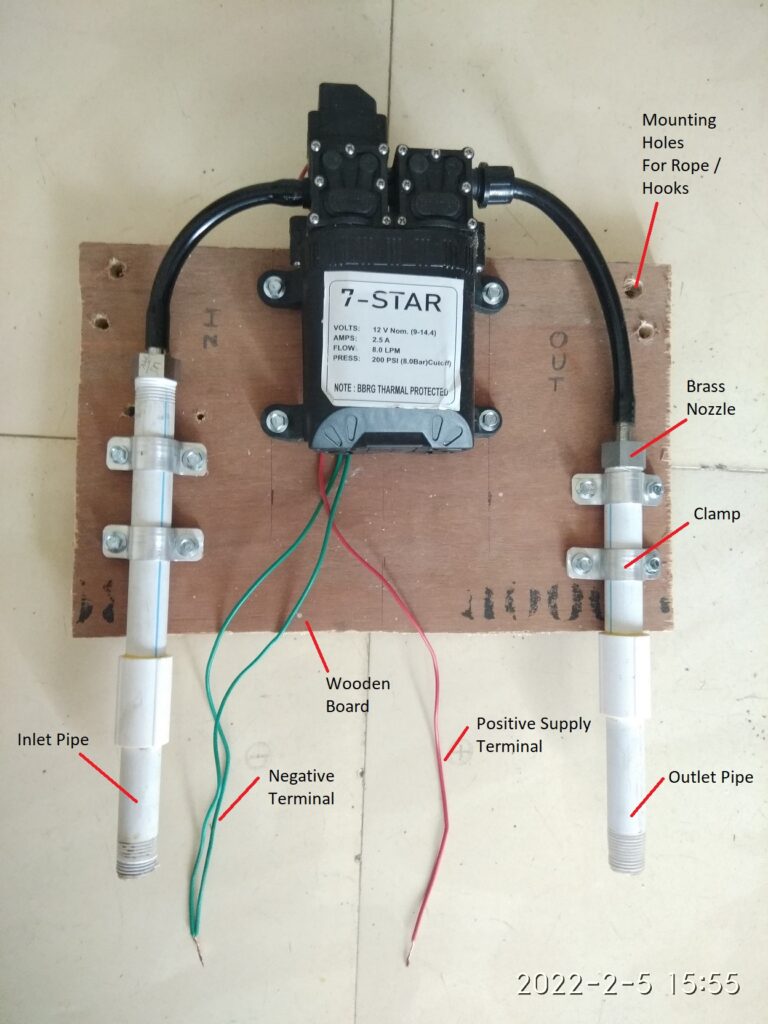
Dual Pump Skid
Front view of the pump skid with inlet and outlet pipes on left side.
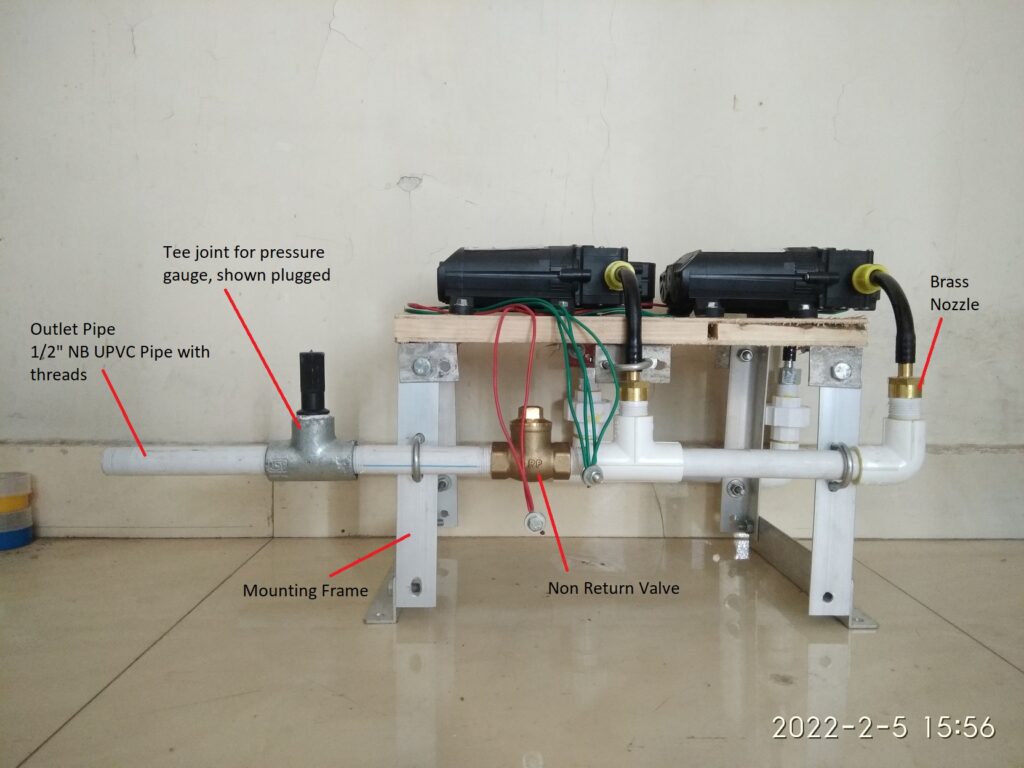
Seen from top at an angle / 3-D view.
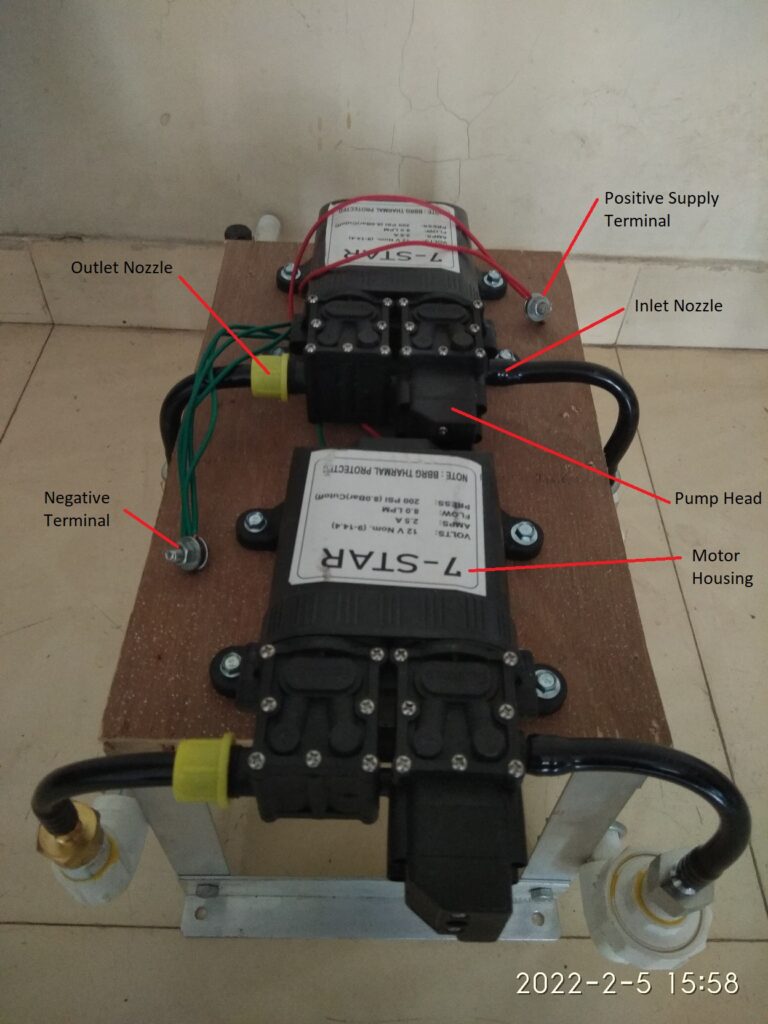
Left Side View
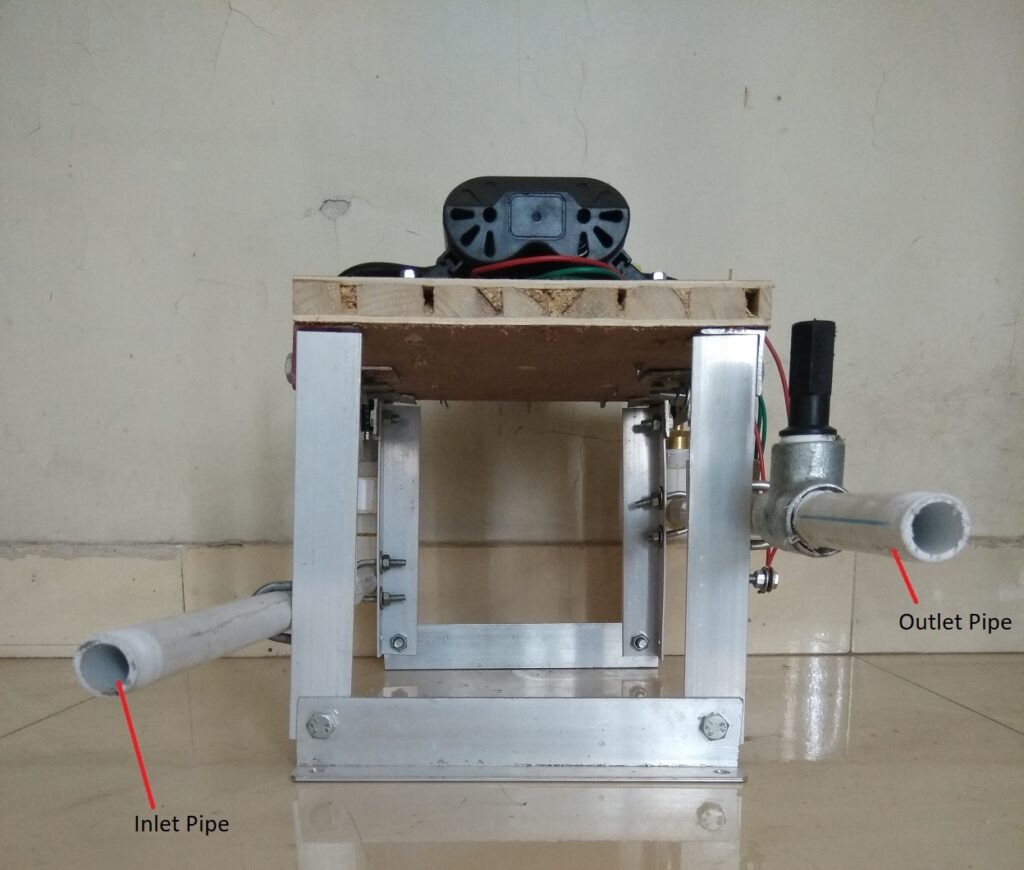
Rear View
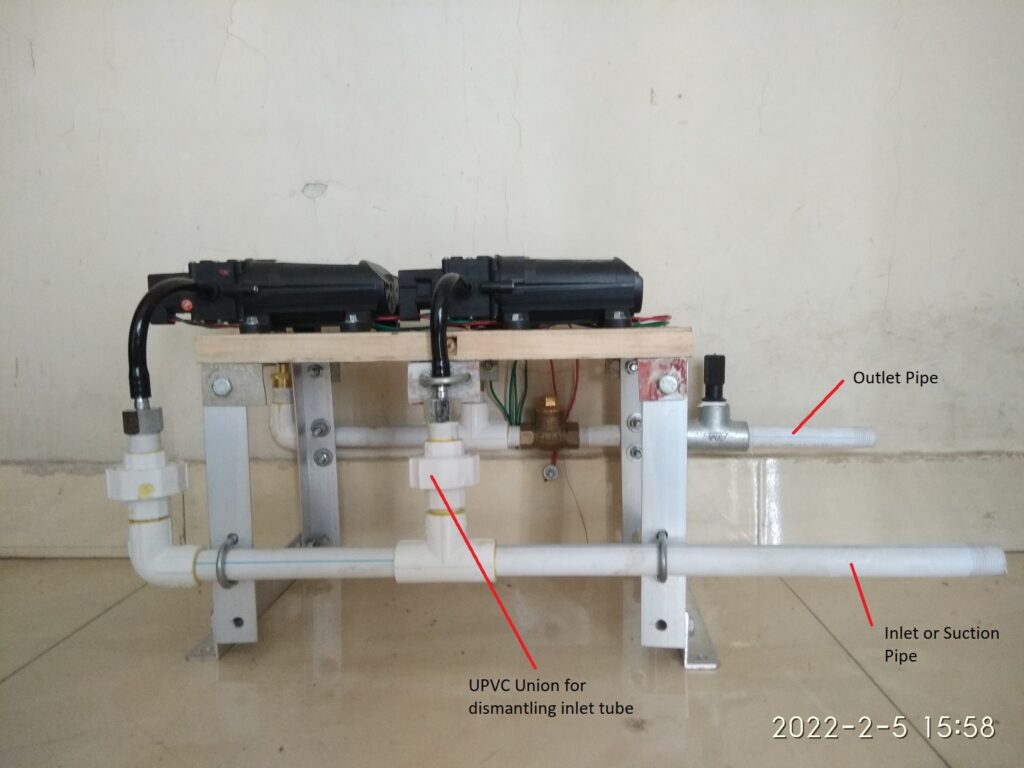
Right Side View
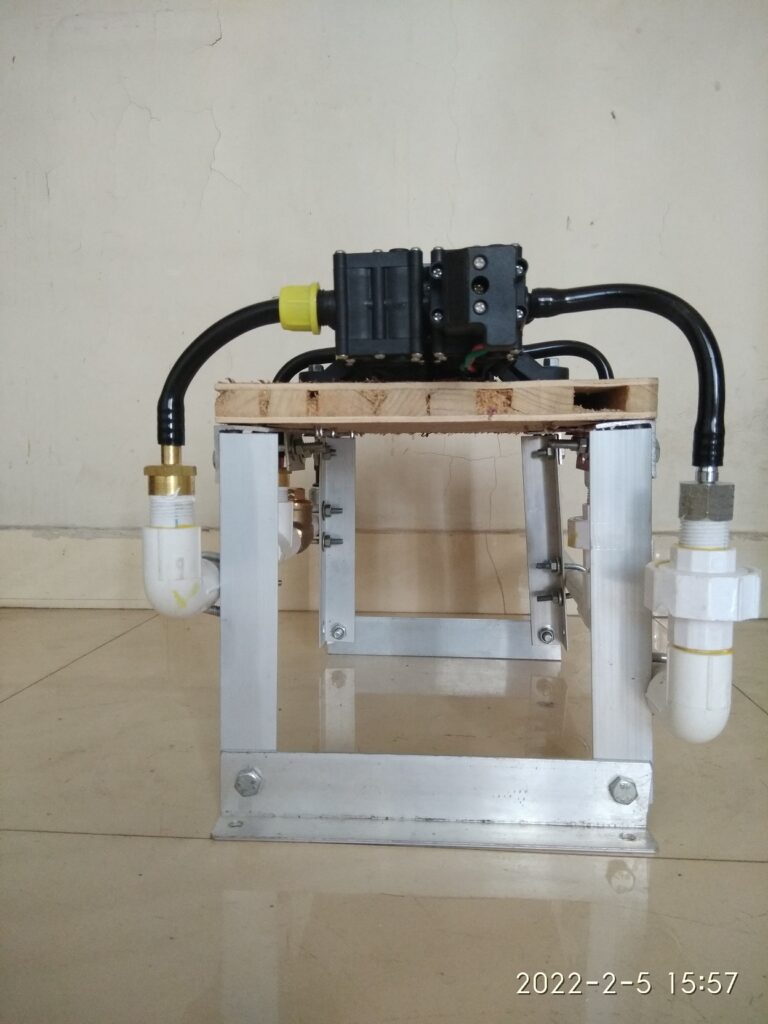
Top View
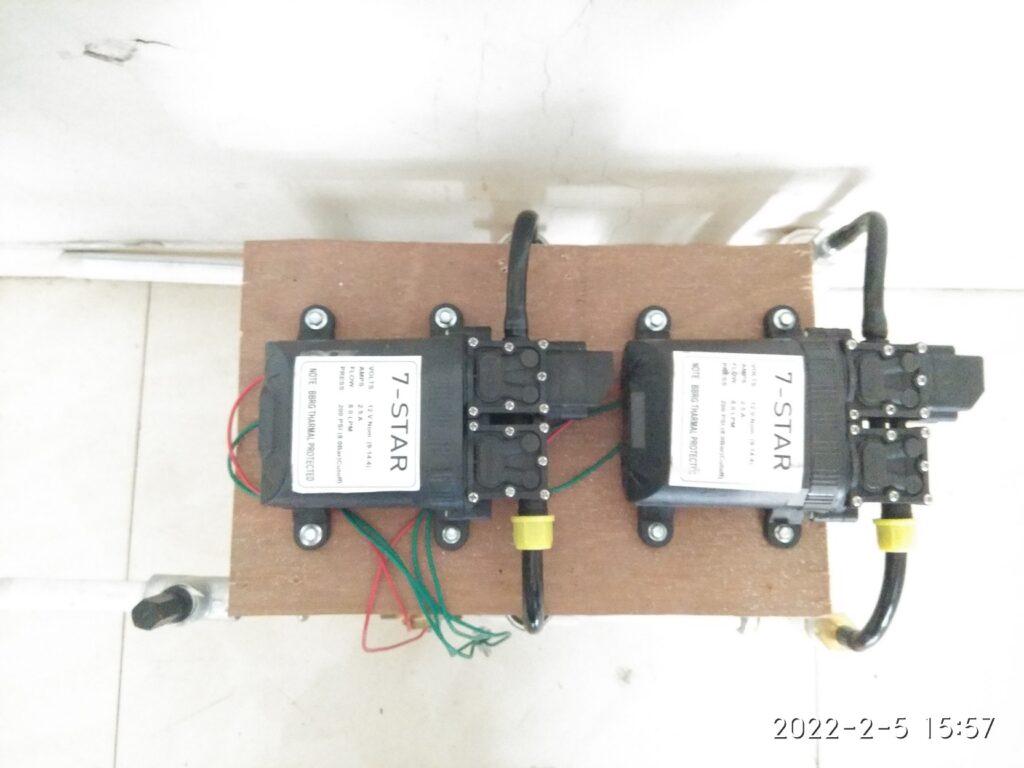
Important Instructions
- Pump and motor must never be submerged in water and water must not get into the motor.
- DC power supply polarity needs to be correctly followed. Green wires to be connected to negative terminal of the battery or solar panels, and red wire to positive terminal.
- DC supply voltage must never exceed 18 volts.
- In no case, AC supply / mains supply shall be applied to the motor, it is hazardous besides the fact that it will permanently damage the motor.
- Testing of pump without water by supplying DC power for a second or say two seconds is ok, but must not run the motor for longer duration without water.
- At the inlet pipe a suitable filter in form of nylon mesh is highly recommended. The internal piston mechanism of the pump is too small to get clogged by smallest of the particles.
- This type of pump can generally start from dry run and can self prime in a few seconds, but if it does not do so, please do not run it dry for long time. Instead open the nozzles and check if any clogging or blockages. Try to pull water from outlet nozzle or pipe by sucking the air.
- The pump can lift water from upto 5-6 feet on the suction side, however it is better to keep the suction pipe length as small as possible.
- It is recommended to install a footvalve at end of the suction pipe submerged inside the water, it is best to attach a filter mesh around the footvalve.
- Make sure that the pump skid is mounted on a sturdy platform or base. Alternatively pump can be suspeneded firmly inside an openwell clearly above the water level.
- Use solar panels of 12VDC nominal voltage only, any higher voltage panels if connected to the pump will damage the same. It is better to first check the nameplate on the backside of the solar panel before connecting for the first time. The nameplate should read 12VDC nominal and/or 17-18 VDC MPPT or maximum power voltage.
- Single pump skid is suitable to operate with 75 to 100 Watt panel and dual pump skid with 150 to 200 Watts. Excessively higher wattage of the solar panels must be avoided.
- This type of pump is supposed to be used for intermittent duty only however through our experimentation in actual sites, we find that using the pump every day for 3 to 5 hours is fine.
- Connect the outlet pipe with suitable coupling or union with the delivery pipe to be arranged at the site to suit the distance of the final delivery location away from the water source.
- Ensure that the inlet and outlet pipe connections do not lead to forces on the pipes or the skid.
- If in doubt please reach out to us through email or phone.
Update on 21-Sep-2022
We have taken measurements of the pressure and flow generated from this type of mini pump and the videos below are useful to understand the performance.
It was seen that when operating with a 16VDC power adapter one twin pump could produce 2 Bar pressure (20 mtr water column equivalent).
At 1.5 bar the pump delivered 180 LPH and at 1.0 bar the pump could deliver 300 LPH of water flow.

